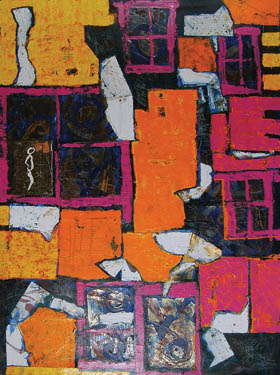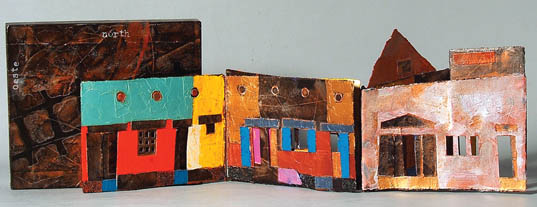In this issue, Shock Art features the work of Denise (Dotson) Low, the poet laureate of Kansas 2007-09 and chair of the English department at Haskell Indian Nations University, Lawrence, Kan. It also spotlights work from Carolyn Leigh, a well-traveled painter and book artist with studios in Tucson, Ariz., and Alamos, Sonora, Mexico.
Cloud Break
“Thus walking — as art — provided an ideal means for me to explore relationships between time, distance, geography and measurement.”
— Richard Long
And so the worked field and the gravel road are sculptural, just as glacial scourings reordered the first-created landscape. Mountains eroded into fields around this day’s rouge sunset.
On this landscape human markings and destructions are as natural as ant hills and beaver dams. Humans walk, sink into soil, build, waste, and mark.
After rain and after winter, loose earth resettles into patterns like those found in wreckage of spring flooded creeks and pitted sandbars. And the artist standing in afternoon shadows also stirs a new world into being.
He is like the Buzzard of Cherokee people who flew over the newly created Earth of Appalachia. As he dragged his feathers, His dipping wings created valleys and mountains that remain to this day. Creation is ongoing, as Buzzards continue to wheel the sky.
The painter, outside walled studios, paces his designs on land. He finds essential forms, as he uncovers boundaries of this earth-prison: “time, distance, geography, measurement.”
— Denise (Dotson) Low ’84
Low, the poet laureate of Kansas 2007-09, chairs the English department at Haskell Indian Nations University, Lawrence, Kan., where she also teaches creative writing and American Indian Studies courses.

City Birds
acrylic and papers on linen, 40”x30”
Carolyn Leigh ’67
Leigh (Fulton) is a well-traveled painter and book artist with studios in Tucson, Ariz., and Alamos, Sonora, Mexico. She explains that “City Birds” is based on visits to Sydney, Australia — specifically “on Oxford Street where there is always something happening, even at 3 in the morning.”

Calle Sin Sombras
artist's book with slipcase acrylic on papers,
variable dimensions
“Calle Sin Sombras,” or “Street Without Shadows,” reflects, Leigh relates, “the changes in Tucson’s barrio architecture after the coming of the railroad brought eastern Anglo influences to mix with the existing Sonoran Spanish style."
The artist works in multiple formats with, as she puts it, “intense colors and dynamic forms, shape-shifting between figurative and abstract.”
Her work is found in private and public collections in the U.S.A., Mexico and Australia. The Wichita State graduate taught scientific illustration at the University of Arizona in Tucson until she joined her husband, Ron Perry, as a tribal art dealer.
They collect in Papua New Guinea and other countries on the Pacific Rim.





